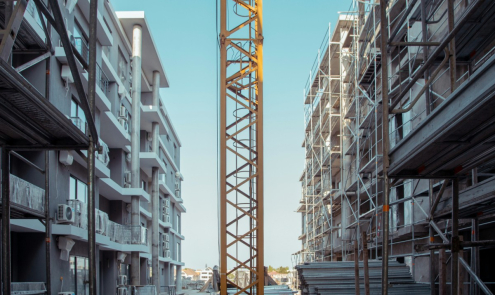EVACUATION SAFETY ALARMS
09 Aug 2022
The government has recently announced improvements to fire safety guidance and building regulations in England to meet recommendations from Phase One of the Grenfell Tower Inquiry published in October 2019. In this two-part series, Managing Director at Whitecode Consulting, Alex Hill, looks at some of the changes and asks if the improvements have gone far enough to ensure that residents are safe in their own homes.
“The reforms announced last month (June 2022) are designed to make new high-rise residential buildings safer by strengthening the information available to fire and rescue services. All new residential buildings over 11m will now have to include a Secure Information Box that will give fire and rescue services access to important details about a building and its residents in the event of a fire.
It will also be mandatory for new residential developments over 18m to have an Evacuation Alert System in place to help fire and rescue services inform residents of a change in evacuation strategy during an incident. These changes form part of a wider update to tighten building regulations and provide clearer fire safety rules for the design and construction of residential developments. Updates to the Buildings Regulation’s guidance known as Approved Document B, will take effect on 1 December 2022 in England.
The National Fire Chiefs Council’s (NFCC) ’stay put’ policy has faced widespread criticism since the Grenfell tragedy. However, the ‘stay put’ strategy relies on the principle of compartmentalisation combined with other fire safety provisions. Compartmentalisation is a design principle intended to inhibit the rapid spread of fire from one flat (compartment) to another. This allows those in flats not affected by the fire to stay put whilst the emergency services tackle the fire. At Grenfell, the man in the flat where the fire started was woken by his smoke alarm, he called the fire brigade and left his flat closing the door behind him and went to warn his neighbours. The combustible cladding on the tower, that did not comply with regulations, behaved in a way that could not have been predicted by the emergency services. Once the cladding caught alight the fire travelled rapidly up the side of the building, breaking in at various points creating a dangerous multi-seated fire. The call to evacuate came sadly too late for many of the tower’s residents who stayed in their homes waiting for the fire to be extinguished.
The principle of compartmentalisation also meant that there was no centrally activated alarm system and only a single staircase in the Grenfell tower block. The Home Office has confirmed that the ‘stay put’ policy is in place for buildings which are designed to give ‘appropriate’ protection from fire which means it is ‘generally safer’ for residents to wait for emergency services to rescue them.
When the call to evacuate came at Grenfell, police resorted to asking people in the large crowd gathered near to the tower to try and contact those who they knew inside and tell them to get out. The inquiry’s experts agreed that the call to evacuate came too late. The London Fire Brigade in its Evacuation and Rescue Policy recognises that there is a lack of guidance in relation to the considerations and actions that need to be assessed by firefighters when evacuating or rescuing large numbers of people. It also stated that the fire demonstrated the high levels of risk that can be created when a building does not behave as fire safety requirements intend and the fire exceeds ‘normal’ expectations. The NFCC has amended its ‘stay put’ strategy to ‘simultaneous evacuation’ in the short term where a building had been identified as a fire risk due to combustible cladding. It also emphasises the need for building owners to install fire alarms as quickly as possible to reduce or remove the dependence on waking watches in buildings where remediation work can’t be undertaken in the short term.
But how can firefighters inform residents of an emergency evacuation? Currently, with extreme difficultly, especially in the case of a tower block because firefighters would normally go door-to-door asking people to leave their homes. This new reform will give firefighters the ability to inform all of the residents quickly and efficiently via an evacuation alarm to evacuate a building. To comply with building regulations and Approved Document B: Fire Safety, the evacuation alert system should be provided in accordance with British Standard (BS) 8629: 2019.
This standard gives recommendation for the design, installation, and maintenance of evacuation alert systems for use by the fire and rescue services in buildings containing flats. It notes that the technical committee responsible for the British Standard acknowledges that ‘stay put’ remains the appropriate strategy for new blocks of flats and that the purpose of the systems described in the British Standard is to provide facilities that can support operational firefighting and rescue in blocks of flats that are designed on the basis of a ‘stay put’ strategy. The scope of the British Standard includes systems that are installed in any building containing flats regardless of height. The evacuation alert system covered by the British Standard comprises evacuation alerts and indicating equipment for the deaf or hard of hearing (EACIE) which incorporates manual controls by which evacuation alert sounders within each flat can be operated by the fire and rescue services. The British Standard does not cover systems in which a warning to occupants is given by a speech message (whether pre-recorded or live), but it does give recommendations on frequency and audibility of the sound of the fire evacuation system.

The Role of MEP Surveys in Cost Management...
MEP surveys are essential for assessing the condition and efficiency of mechanical, electrical, and plumbing (MEP) systems in buildings.
Read More
IS THE TRANSITION TO HEAT PUMPS WORTH THE...
As we contend with the global need to reduce carbon emissions and combat climate change, the UK government is introducing bold initiatives to transition away from fossil fuels. One such initiative is the ban on new gas boilers,...
Read MoreLike to Know More? Let's Talk...







